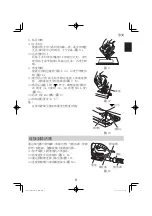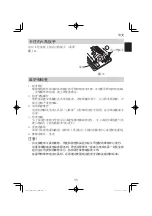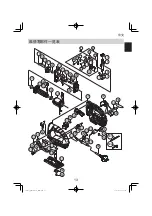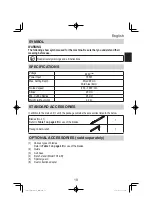
English
23
3. Cutting a circle or a circular arc
The guide also will be helpful for circular cutting.
After attaching the guide by same way noted as
above, drive the nail or screw into the material
through the hole on the guide, then use it for an
axis when cutting. (
Fig. 10
)
NOTE
Circular cutting must be done with the blade
approximately vertical to the bottom surface of
the base.
4. Cutting metallic materials
(1) Adjust the speed Dial between scales “3” and “4”.
(2) Set the orbital position to “0” or “
I
”.
(3) Always use an appropriate cutting
fl
uid (spindle oil,
soapy water, etc.). When a liquid cutting
fl
uid is not
available, apply grease to the back surface of the
material to be cut.
5. Pocket
cutting
(1) In
lumber
Aligning the blade direction with the grain of the wood,
cut step by step until a window hole is cut in the center
of the lumber. (
Fig. 11
)
(2) In other materials
When cutting a window hole in materials other than
lumber, initially bore a hole with a drill or similar tool
from which to start cutting.
6. Angular
cutting
The base can be swiveled to both sides by up to 45°
for angular cutting. (
Fig. 12
)
(1) Loosen the base bolt by hexagonal bar wrench
attached on base and move the base fully forward.
(
Fig. 7
,
8
)
(2) Align the scale (from 0 degrees to 45 degrees by
15-degree increments) of the semi-circular part of
the base with the [ ] mark on the gear cover.
(
Fig. 13
)
(3) Tighten the M5 bolt again. (
Fig. 7
)
(4) Set the orbital position to “0”.
NOTE
Angular cutting can not be done when adopting
dust collector.
Guide
Guide hole
Nail or screw
Fig. 10
Fig. 11
Base
Fig. 12
-
mark
Scale
Semi-circular part
Fig. 13
000Book_CJ90VST_ChS.indb 23
000Book_CJ90VST_ChS.indb 23
2015/7/22 17:23:46
2015/7/22 17:23:46










































